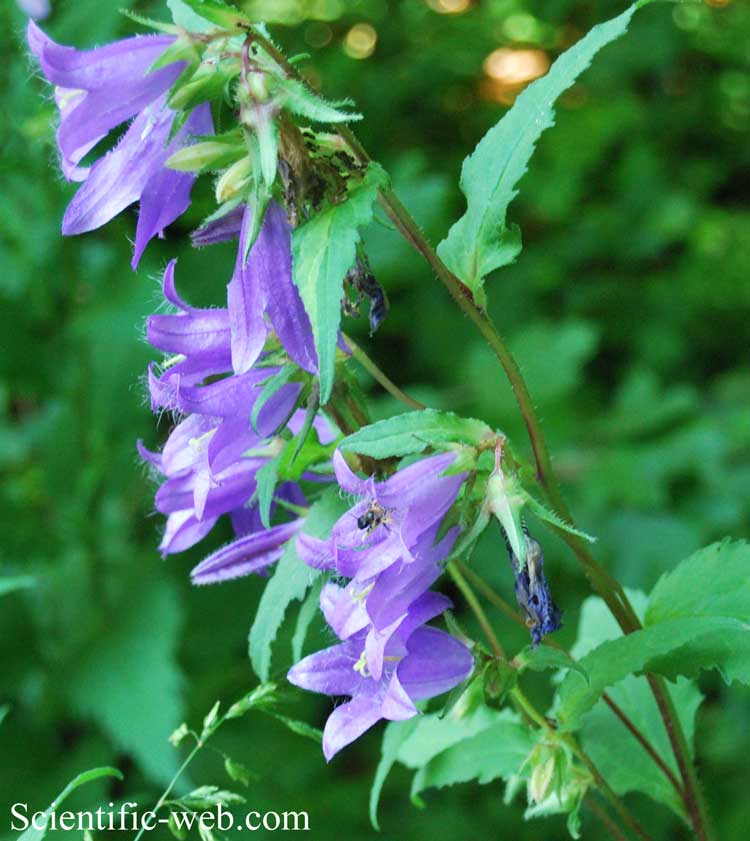
Campanula trachelium, Photo: Michael Lahanas
Classification System: APG IV
Superregnum: Eukaryota
Regnum: Plantae
Cladus: Angiosperms
Cladus: Eudicots
Cladus: Core eudicots
Cladus: Asterids
Cladus: Campanulids
Ordo: Asterales
Familia: Campanulaceae
Subfamilia: Campanuloideae
Genus: Campanula
Species: Campanula trachelium
Subspecies: C. trachelium subsp. athoa - C. trachelium subsp. mauritanica - C. trachelium subsp. trachelium
Name
Campanula trachelium L., Sp. Pl.: 166 (1753).
Synonyms
Homotypic
Campanula urticifolia Salisb., Prodr. Stirp. Chap. Allerton: 127 (1796), nom. superfl.
Trachelioides vulgaris Opiz, Seznam: 98 (1852), nom. superfl.
Campanula serratifolia var. ciliatosepala Vuk., Linnaea 26: 335 (1854), nom. illeg.
Drymocodon trachelium (L.) Fourr., Ann. Soc. Linn. Lyon, n.s., 17: 111 (1869).
Distribution
Native distribution areas:
Campanula trachelium
Continental: Eurasia
Albania; Algeria; Altay; Austria; Baltic States; Belarus; Belgium; Bulgaria; Central European Russia; Czechoslovakia; Denmark; East European Russia; Finland; France; Germany; Great Britain; Greece; Hungary; Iran; Ireland; Italy; Kazakhstan; Krym; Lebanon-Syria; Netherlands; North European Russia; Northwest European Russia; Norway; Poland; Qubec; Romania; Sicilia; South European Russia; Spain; Sweden; Switzerland; Turkey; Turkey-in-Europe; Ukraine; Siberia; Yugoslavia
Continental: Africa
Marocco, Tunisia
References: Brummitt, R.K. 2001. TDWG – World Geographical Scheme for Recording Plant Distributions, 2nd Edition
References
Linnaeus, C. 1753. Species Plantarum. Tomus I: 166. Reference page.
Links
Govaerts, R. et al. 2019. Campanula trachelium in Kew Science Plants of the World online. The Board of Trustees of the Royal Botanic Gardens, Kew. Published online. Accessed: 2019 Jul. 25. Reference page.
Hassler, M. 2019. Campanula trachelium. World Plants: Synonymic Checklists of the Vascular Plants of the World In: Roskovh, Y., Abucay, L., Orrell, T., Nicolson, D., Bailly, N., Kirk, P., Bourgoin, T., DeWalt, R.E., Decock, W., De Wever, A., Nieukerken, E. van, Zarucchi, J. & Penev, L., eds. 2019. Species 2000 & ITIS Catalogue of Life. Published online. Accessed: 2019 Jul. 25. Reference page.
International Plant Names Index. 2019. Campanula trachelium. Published online. Accessed: Jul 25 2019.
The Plant List 2013. Campanula trachelium in The Plant List Version 1.1. Published online. Accessed: 2019 Jul 25.
Tropicos.org 2019. Campanula trachelium. Missouri Botanical Garden. Published online. Accessed: 25 Jul 2019.
USDA, ARS, Germplasm Resources Information Network. Campanula trachelium in the Germplasm Resources Information Network (GRIN), U.S. Department of Agriculture Agricultural Research Service.
Vernacular names
العربية: جريس خشن
čeština: zvonek kopřivolistý
Cymraeg: Clychlys dail danadl
Deutsch: Nesselblättrige Glockenblume
English: nettle-leaved bellflower
español: campana vulgar con hoja de ortiga, campanilla, campanillas
eesti: Nõgeselehine kellukas
suomi: Varsankello
français: Campanule gantelée
Gaeilge: Scornlus
magyar: Csalánlevelű harangvirág
lietuvių: Dilgialapis katilėlis
norsk bokmål: Nesleklokke
Nederlands: Ruig klokje
polski: Dzwonek pokrzywolistny
русский: Колокольчик крапиволистный
slovenčina: zvonček pŕhľavolistý
svenska: Nässelklocka
Türkçe: Isırgan yapraklı çan çiçeği
Campanula trachelium, the nettle-leaved bellflower,[1] is a species of bellflower. It is a Eurasian blue wildflower native to Denmark and England and now naturalized in southeast Ireland. It is also found southward through much of Europe into Africa.
Contents
1 Common names
2 Description
3 Habitat
4 References
5 External links
Common names
The alternate name throatwort is derived from an old belief that C. trachelium is a cure for sore throat, and the species name trachelium refers to its use as treatment of the throat in folk medicine.[2]
Other folknames include Our Lady's Bells because the color blue was identified with the Virgin Mary's scarf, veil, or shawl; Coventry Bells because C. trachelium was especially common in fields around Coventry; and "Bats-in-the-Belfry" or in the singular "Bat-in-the-Belfry", because the stamens inside the flower were like bats hanging in the bell of a church steeple.[3]
Description
Campanula trachelium is a perennial plant with one or more unbranched, often reddish, square-edged stems that are roughly hairy. The leaves grow alternately up the stems. The lower leaves are long-stalked and ovate with a heart-shaped base. The upper leaves have no stalks and are ovate or lanceolate, hairy with toothed margins. The inflorescence is a one sided spike with a few slightly nodding flowers. Each flower has five sepals which are fused, erect and hairy, and the five violet (or occasionally white) petals are fused into a bell that is hairy inside. There are five stamens and a pistil formed from three fused carpels. The fruit is a hairy, nodding capsule.[4]
Habitat
Campanula trachelium likes humus-rich soil and is found in broad-leaved woodlands, coppices, hedgerows and the margins of forests.[4]
References
BSBI List 2007 (xls). Botanical Society of Britain and Ireland. Archived from the original (xls) on 2015-06-26. Retrieved 2014-10-17.
"Campanula trachelium 'Bernice' - Dorset Perennials". dorsetperennials.co.uk.
"Paghat's Garden". www.paghat.com.
"Nettle-leaved Bellflower: Campanula trachelium". NatureGate. Retrieved 2013-12-30.
Retrieved from "http://en.wikipedia.org/"
All text is available under the terms of the GNU Free Documentation License

